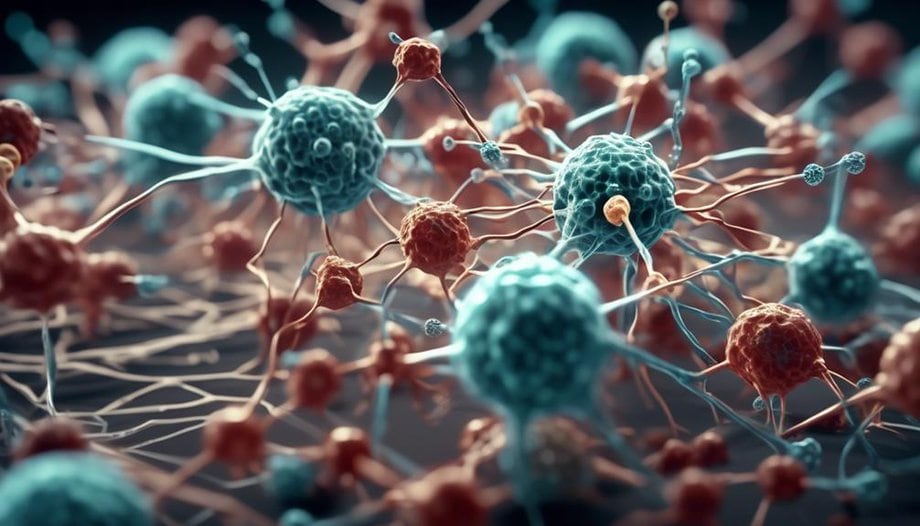Discovery of T-Cells and B-Cells (1960s) – Miller & Cooper: Recap and Summary: Key to Understanding the Immune System

T-cells and B-cells are key players in our immune system that work together to defend our bodies against pathogens and foreign substances.
Their discovery in the 1960s revolutionized our understanding of immune responses and paved the way for advancements in disease treatment and prevention.
Key Takeaways
- T-cells and B-cells play crucial roles in the immune response by identifying and neutralizing pathogens.
- B-cells originate from stem cells in the bone marrow and produce antibodies to mark antigens for destruction.
- T-cells and B-cells interact with each other, contributing to the formation of immunological memory.
- Understanding the functions of T-cells and B-cells has important implications for disease treatment and prevention, including therapies targeting these cells, vaccination, immunotherapy for cancer, and management of autoimmune disorders.
Background on Miller & Cooper's Research
In order to provide a comprehensive understanding of T-cells and B-cells, it's essential to delve into the background of Miller & Cooper's groundbreaking research. Miller & Cooper's research impact can't be overstated, as their discovery of T cells and B cells revolutionized our understanding of the immune system.
Back in the 1960s, Miller and Cooper conducted experiments that laid the foundation for our current knowledge of T cells and B cells. Their research highlighted the importance of these specialized cells in the immune response. T cells, named after the thymus gland where they mature, play a crucial role in cell-mediated immunity, recognizing and destroying infected cells. B cells, on the other hand, produce antibodies that target specific pathogens, marking them for destruction.
Through their rigorous experiments and meticulous observations, Miller and Cooper established the existence and significance of T cells and B cells. This discovery paved the way for further research in immunology and opened up new avenues for developing treatments and vaccines.
Miller & Cooper's research remains relevant today, serving as the cornerstone of our understanding of the immune system and its defense mechanisms. Their pioneering work laid the groundwork for future breakthroughs, making their contribution invaluable to the field of immunology.
Identification and Characterization of T-Cells
T-cells, also known as T lymphocytes, play a crucial role in the immune system by recognizing and destroying infected cells. They're a type of white blood cell that are responsible for cell-mediated immunity, which is the immune response that involves the activation of T-cells to fight off pathogens.
Here are some key points about the identification and characterization of T-cells:
- T cell receptors: T-cells have specific receptors on their surface called T cell receptors (TCRs). These receptors allow T-cells to recognize antigens, which are molecules found on the surface of infected cells or pathogens.
- T cell differentiation: T-cell differentiation is a process in which T-cells develop into different subtypes, each with specific functions. This process is important for the proper functioning of the immune system.
- Helper T-cells: Helper T-cells, also known as CD4+ T-cells, play a crucial role in coordinating the immune response. They help activate other immune cells, such as B-cells and cytotoxic T-cells, to eliminate pathogens.
- Cytotoxic T-cells: Cytotoxic T-cells, also known as CD8+ T-cells, are responsible for directly killing infected cells. They recognize and destroy cells that are infected with viruses, bacteria, or cancerous cells.
Understanding the identification and characterization of T-cells is essential for comprehending the complexities of the immune system and developing strategies for enhancing immune responses.
Discovery and Functions of B-Cells
Let's now explore the fascinating world of B-cells and their crucial role in the immune system.
B-cell development is a complex process that starts in the bone marrow and continues in the lymphoid organs.
Once mature, B-cells produce antibodies, which are specialized proteins that recognize and neutralize harmful pathogens.
Understanding the functions of B-cells is essential for comprehending the intricate workings of our immune system.
B-Cell Development
B-Cell development encompasses the fascinating journey of these vital immune cells as they mature and acquire their unique functions. Here are four key aspects of B-cell development:
- B cell differentiation: B-cells originate from hematopoietic stem cells in the bone marrow. During differentiation, they undergo a series of complex genetic and epigenetic changes that result in the formation of mature B-cells.
- Maturation in the bone marrow: B-cells undergo a maturation process in the bone marrow, where they acquire surface markers and rearrange their antibody genes. This ensures that each B-cell expresses a unique antibody on its surface.
- Migration to secondary lymphoid organs: Mature B-cells leave the bone marrow and migrate to secondary lymphoid organs, such as the spleen and lymph nodes, where they await activation by antigens.
- B cell activation: Upon encountering an antigen, B-cells become activated and undergo clonal expansion. This leads to the production of plasma cells that secrete antibodies and memory B-cells that provide long-term immunity.
Understanding B-cell development is crucial for comprehending the immune response and designing effective vaccines and therapies.
Antibody Production
B-Cells play a crucial role in the immune system by producing antibodies, which are essential for fighting off infections and providing long-term immunity. Antibodies, also known as immunoglobulins, are proteins that are produced by B-Cells in response to the presence of foreign substances, such as bacteria or viruses.
When a B-Cell encounters an antigen, it undergoes a process called antibody production, where it produces specific antibodies that can bind to and neutralize the antigen. This immune response is highly specific, as each B-Cell produces antibodies that are tailored to recognize a particular antigen.
Once the antibodies are produced, they can circulate in the body, binding to the antigens and marking them for destruction by other immune cells.
This process of antibody production is crucial for the immune system to effectively fight off infections and provide long-lasting protection against future exposures.
Interactions Between T-Cells and B-Cells
T-Cells and B-Cells interact with each other in a coordinated and essential manner to mount effective immune responses. These interactions play a crucial role in the activation of both cell types and the subsequent immune response. Here are four key aspects of the interactions between T-Cells and B-Cells:
- T-Cell Activation: T-Cells undergo activation when they encounter an antigen-presenting cell, such as a dendritic cell, that has processed and presented the antigen. This interaction leads to the activation of T-Cells, which then play a central role in coordinating the immune response.
- B-Cell Activation: B-Cells are activated when they encounter an antigen that matches their specific B-cell receptor. This activation can occur through direct recognition or with the help of T-Cells. Once activated, B-Cells differentiate into plasma cells, which produce antibodies specific to the encountered antigen.
- T-Cell Help: T-Cells provide essential help to B-Cells during their activation and differentiation. This help involves direct cell-to-cell interactions and the release of signaling molecules that enhance B-Cell activation and antibody production.
- Memory Response: The interactions between T-Cells and B-Cells also contribute to the formation of immunological memory. Memory B-Cells and T-Cells are generated during the initial immune response and provide long-term protection against subsequent encounters with the same antigen.
Understanding the interactions between T-Cells and B-Cells is crucial for developing effective strategies to harness the immune system for therapeutic purposes, such as vaccine development and immunotherapy.
Role of T-Cells and B-Cells in Immune Response
Now let's delve into the role of T-cells and B-cells in the immune response.
T-cells play a crucial role in activating other immune cells and coordinating the immune response. They recognize and bind to antigens presented by antigen-presenting cells, triggering a cascade of events that leads to immune activation.
B-cells, on the other hand, are responsible for producing antibodies that can neutralize pathogens and mark them for destruction.
Additionally, both T-cells and B-cells contribute to the formation of immune memory, allowing for a faster and more effective response to future infections.
T-Cell Activation Mechanism
The activation mechanism of T-cells plays a crucial role in the immune response by coordinating with B-cells to identify and eliminate foreign pathogens. Here are four key points to understand the T-cell activation mechanism:
- T-cell signaling: T-cells receive signals from antigen-presenting cells (APCs) that have engulfed and processed foreign antigens. These signals activate the T-cells and initiate the immune response.
- T-cell receptor activation: T-cells have specific receptors on their surface that bind to antigens presented by APCs. This binding triggers a series of intracellular signals, leading to T-cell activation.
- Co-stimulation: T-cell activation requires a second signal called co-stimulation. Co-stimulatory molecules on APCs interact with receptors on T-cells, providing the additional signal needed for full activation.
- Effector function: Once activated, T-cells differentiate into effector cells that carry out various functions such as killing infected cells or secreting cytokines to recruit other immune cells.
Understanding the T-cell activation mechanism is crucial for developing targeted therapies and vaccines to enhance immune responses against pathogens.
B-Cell Antibody Production
B-Cell antibody production is a crucial aspect of the immune response, working in tandem with T-Cells to combat foreign pathogens. When a B-Cell encounters an antigen, it undergoes a process called activation. This activation occurs when the antigen binds to the B-Cell receptor, triggering a series of signaling events.
The B-Cell then differentiates into plasma cells, which are responsible for producing and secreting antibodies. Antibodies play a vital role in the immune response by neutralizing pathogens and marking them for destruction by other immune cells.
One remarkable feature of B-Cell antibody production is the generation of antibody diversity. Through a process called somatic hypermutation, B-Cells can modify their antibody genes, leading to the production of millions of unique antibodies that can recognize a wide range of antigens.
This diversity allows the immune system to effectively respond to a variety of pathogens, providing us with the freedom to defend against countless invaders.
Immune Memory Formation
During the immune response, T-Cells and B-Cells work together to form immune memory, a crucial component of our body's defense against recurring pathogens. Here are four key points to understand about immune memory formation and its role in providing long-term immunity:
- Recognition: When a pathogen enters the body for the first time, B-Cells produce specific antibodies that bind to the pathogen, while T-Cells recognize and destroy infected cells.
- Activation: During this initial encounter, a small number of B-Cells and T-Cells become memory cells, which have a longer lifespan compared to the effector cells involved in the immediate immune response.
- Rapid Response: If the same pathogen enters the body again, memory B-Cells quickly produce antibodies, while memory T-Cells rapidly recognize and destroy infected cells. This accelerated response helps to eliminate the pathogen before it can cause significant harm.
- Long-Term Protection: Immune memory formation provides long-lasting immunity, protecting against future infections by the same pathogen. This is why individuals who've recovered from certain diseases or have been vaccinated show increased resistance to reinfection.
Understanding the mechanisms behind immune memory formation is crucial for developing effective vaccines and treatments to combat infectious diseases.
Implications for Disease Treatment and Prevention
Understanding the role of T-cells and B-cells in disease treatment and prevention is crucial for developing effective strategies for combating various illnesses. These cells play a vital role in the immune system's response to pathogens and have led to the development of targeted therapies and disease prevention strategies. Let's take a closer look at some of these implications:
| Implication | Description | Example |
|---|---|---|
| Targeted Therapies | Utilizing the specificity of T-cells and B-cells to target and eliminate diseased cells. | CAR-T cell therapy for cancer treatment. |
| Vaccination | Stimulating the production of memory B-cells to provide long-term protection against specific pathogens. | Administration of the flu vaccine to prevent influenza infection. |
| Immunotherapy | Enhancing the immune system's response to cancer cells by activating T-cells and B-cells. | Checkpoint inhibitors for melanoma treatment. |
| Autoimmune Disorders | Modulating the activity of T-cells and B-cells to prevent them from attacking healthy cells and tissues. | Immunosuppressive drugs for rheumatoid arthritis management. |
Current Research and Future Directions
Current research is shedding light on the intricate interactions between T-cells and B-cells, paving the way for future advancements in disease treatment and prevention strategies. Scientists are delving deeper into the mechanisms by which these immune cells communicate and cooperate to mount an effective immune response.
Here are four key areas of current research and future directions:
- Immunotherapy: Researchers are exploring the use of T-cells and B-cells in developing novel immunotherapies. These therapies aim to harness the power of the immune system to target and eliminate cancer cells, offering a promising approach in the fight against cancer.
- Vaccine development: By studying the interactions between T-cells and B-cells during immune responses, scientists are gaining insights into how to design more effective vaccines. This could lead to the development of vaccines that provide long-lasting immunity and better protection against infectious diseases.
- Autoimmune diseases: Current research is focused on understanding the role of T-cells and B-cells in autoimmune diseases such as rheumatoid arthritis and multiple sclerosis. By deciphering the underlying mechanisms, researchers hope to develop targeted therapies that can modulate the immune response and provide relief to patients.
- Aging and immunity: Aging is known to have an impact on the immune system. Future research aims to uncover how T-cells and B-cells change with age and how these changes contribute to increased susceptibility to infections and decreased vaccine efficacy. This knowledge could inform the development of interventions to boost immune function in the elderly.
Summary and Key Takeaways
To summarize the current research and key takeaways, the intricate interactions between T-cells and B-cells have opened up new possibilities for immunotherapy, vaccine development, understanding autoimmune diseases, and addressing age-related changes in immunity. The importance of T-cells and B-cells in the immune system cannot be overstated. T-cells play a crucial role in recognizing and destroying infected cells, while B-cells produce antibodies that neutralize pathogens. Together, they form a powerful defense against infections and diseases.
One key takeaway is the potential of T-cells and B-cells in immunotherapy. Researchers are exploring ways to harness these cells to treat cancer and other diseases by enhancing their ability to target and eliminate abnormal cells. This approach shows promise in improving patient outcomes and reducing side effects compared to traditional treatments.
Another key takeaway is the significance of T-cells and B-cells in vaccine development. By understanding how these cells recognize and respond to pathogens, scientists can design vaccines that elicit a strong and specific immune response. This knowledge has already led to the development of effective vaccines against various infectious diseases.
Understanding the role of T-cells and B-cells is also crucial in deciphering autoimmune diseases. These conditions occur when the immune system mistakenly attacks healthy cells and tissues. By studying the interactions between T-cells and B-cells, researchers can gain insights into the underlying mechanisms of autoimmune diseases and develop targeted therapies.
Lastly, the impact of T-cells and B-cells on age-related changes in immunity is significant. As we age, the immune system weakens, making older adults more susceptible to infections and diseases. Understanding how T-cells and B-cells function in the aging immune system can help develop strategies to enhance immune responses and improve overall health in the elderly.
In summary, the key takeaways from the research on T-cells and B-cells highlight their importance in immunotherapy, vaccine development, understanding autoimmune diseases, and addressing age-related changes in immunity. This knowledge opens up new possibilities for improving health and well-being, offering hope for a future where diseases can be effectively treated and prevented.
| Key Takeaways | Importance of T-cells and B-cells |
|---|---|
| Immunotherapy | Harnessing cells to treat diseases |
| Vaccine development | Designing effective vaccines |
| Autoimmune diseases | Deciphering underlying mechanisms |
| Age-related changes | Improving immune responses in the elderly |
Frequently Asked Questions
How Did Miller and Cooper's Research on T-Cells and B-Cells Impact the Field of Immunology?
Miller and Cooper's research on T-cells and B-cells revolutionized immunology, leading to significant advancements. Their findings had a profound impact on understanding the immune system, paving the way for further research and breakthroughs in the field.
What Are Some Potential Applications of Understanding the Interactions Between T-Cells and B-Cells in Disease Treatment and Prevention?
Understanding the interactions between T-cells and B-cells can lead to personalized immunotherapy and vaccine development, revolutionizing disease treatment and prevention. You have the potential to make a significant impact in the field of medicine.
Are There Any Limitations or Challenges in Studying the Functions of T-Cells and B-Cells?
Studying the functions of T cells and B cells has limitations and challenges. Techniques used can be like trying to untangle a knot, and the complex interactions between these cells add to the difficulty.
What Are Some Current Areas of Research and Future Directions in the Study of T-Cells and B-Cells?
In studying T cells and B cells, current research focuses on understanding their interactions in cancer and the role they play in autoimmune diseases. Future directions aim to uncover new therapies and treatments for these conditions.
Can the Role of T-Cells and B-Cells in the Immune Response Vary Depending on the Type of Disease or Condition?
Yes, the role of T-cells and B-cells in the immune response can vary depending on the type of disease or condition. They play a crucial role in autoimmune diseases and can influence cancer progression.









